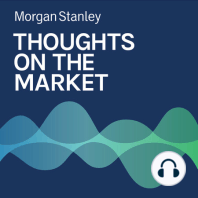3 min listen
Mike Wilson: Unpacking the Latest CPI
ratings:
Length:
4 minutes
Released:
Feb 15, 2022
Format:
Podcast episode
Description
As the Fed grapples with new data from last week's Consumer Price Index report, markets are pricing a move away from the dovish policy of the past and investors should pay attention.----- Transcript -----Welcome to Thoughts on the Market. I'm Mike Wilson, Chief Investment Officer and Chief U.S. Equity Strategist for Morgan Stanley. Along with my colleagues, bringing you a variety of perspectives, I'll be talking about the latest trends in the financial marketplace. It's Tuesday, February 15th at 10 a.m. in New York. So let's get after it.While there are many moving parts in any market environment, investors often become infatuated with one in particular. In our view, going into last Thursday's consumer price index report was one of those times. For the days leading into it every conversation with investors, traders, and the media obsessed over the report and whether markets were appropriately priced. For the inflation bulls the release did not disappoint, coming in significantly stronger than expected with the components of the report just as hot.Immediately after its release, both short- and longer-term interest rates surged. Additional policy hawkishness was quickly priced too, as markets concluded the Fed was falling even further behind the curve. Market chatter of an emergency Fed meeting made the rounds, indicating the possibility of immediate cessation of quantitative easing or even an intra-meeting rate hike. By the end of the day on Thursday markets had priced in a 90% chance of a 50 basis point hike at the March meeting, and six to seven 25 basis points worth of hikes by the end of the year. Balance sheet runoff, or quantitative tightening, is also expected to begin by the middle of this year at the rate of $80 billion a month.When we first started talking about ‘Fire and Ice’ last September, our view that the Fed would have to go faster than expected to fight the building inflationary pressure was met with quite a bit of skepticism, and for a good part of the fall markets disagreed too. Some of this was due to the fact that most investors in markets like to see the hard data before positioning for it. The other reason is likely due to how the Fed and other central banks have behaved since the financial crisis, with their dovish policy bias. Fast forward to today and the data is irrefutable. Doves are quickly going extinct, and it's become almost a competition as who can have the most hawkish forecasts at this point.While we don't doubt the Fed and other central banks resolve to try and get inflation back under control, the market is now all in on the idea that they will do their job to fight inflation. However, we find ourselves a bit more skeptical that they will be able to get as much policy tightening done as is now expected and priced. Furthermore, when something is this obvious and consensus, it's usually time to start focusing on something else.As noted in the past several weeks, we think the equity markets will now begin to focus on growth or the lack thereof. In short, one should begin to worry about the ‘ice,’ now that ‘fire’ is finally appreciated. One of the reasons we are skeptical of the Fed and other central banks will be able to deliver on the policy tightening now expected, is the fact that growth is already slowing. An unusual circumstance at the beginning of any monetary policy tightening cycle, particularly one that is so ambitious. Whether it's the pay back in demand, or the sharp decline in real personal disposable income, we think the rate of consumption is likely to disappoint expectations in the first half of 2022. Furthermore, this weaker consumption is arriving just as supply chains are finally loosening up, something that is likely to be aided by the end of Omicron and the labor shortages it has created in the transportation and logistics industries. In that regard, Friday's consumer confidence survey release looks to be the more important macro data point of the week, not the CPI.Bottom li
Released:
Feb 15, 2022
Format:
Podcast episode
Titles in the series (100)
Michael Zezas: Three Possible Trade Paths from the G20 by Thoughts on the Market
